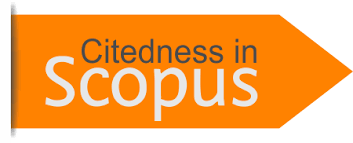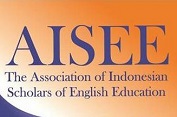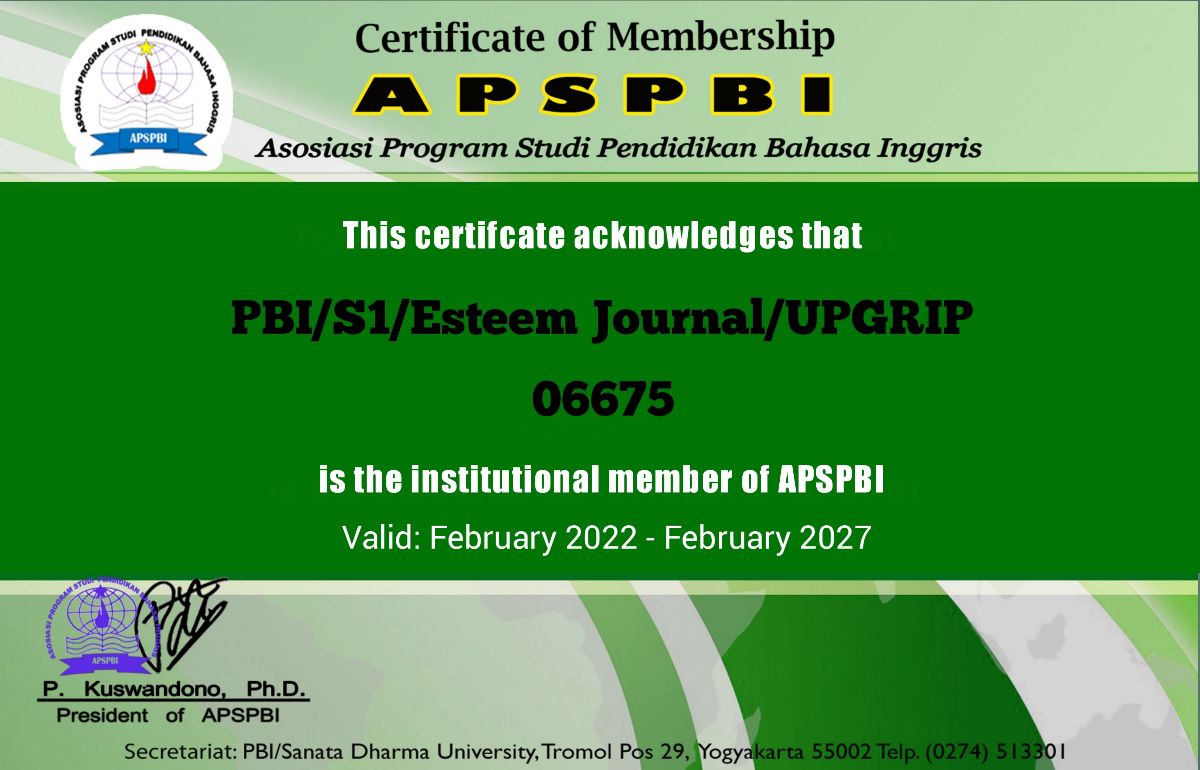THE EFFECT OF ROUND ROBIN BRAINSTORMING STRATEGY IN SOLVING SPEAKING ANXIETY OF TENTH GRADE STUDENTS OF SMK MUHAMMADIYAH PAGARALAM
DOI:
https://doi.org/10.31851/esteem.v6i1.10538Keywords:
Round Robin Brainstorming, Speaking Ability, Speaking AnxietyAbstract
The aimed of this research was to find out the effect of Round Robin Brainstorming in solving students’ speaking anxiety. the writer compared level of students’ speaking anxiety and students’ speaking ability to find out the effect of Round Robin Brainstorming before and after being taught by Round Robin Brainstorming. The researcher took one class as the sample that consist of 30 students from X Multimedia 2 of SMK Muhammadiyah Pagaralam. The data was collected by using two instruments. The first is a speaking test to measure students' speaking ability, The second instrument used was a questionnaire sheet (FLCAS) consisting of 33 items that adopted from Horwitz et al (1986) with scoring Likert’s scale and analyzed manually used Oetting’s scale to categorize students’ speaking anxiety levels. The result showed that there was significant progress in the students’ speaking ability and students’ speaking anxiety was reduce after being taught by using round robin brainstorming strategy.
References
Brown, H. (2003). Language assessment principles and classroom practice. San Fransisco, SA: Pearson Education
Chastain, K. (1998). Developing second language skills (2nd Ed.). Chicago: Harcourt Brace Publishers.
DelliCarpini, M. (2006). scaffolding and differentiating instruction in mixed ability esl classes using a round robin activity. The internet TESL journal, 7(3). Lehman Collage, The City University of New York. Retrieve from http://itslj.org/Techniques/DelliCarpiniRoundRobin.html
Fraenkel, J. R., &Wallen, N. E. (2009). How to design and evaluate research in education. New York, NY: McGraw-Hill.
Horwitz, E. K., Horwitz, M. B., & Cope, J. A. (1986). Foreign language classroom anxiety. In E. K. Horwitz & D. J. Young (Eds.). Language anxiety from theory and research to classroom implications. Englewood Cliffs, New Jersey, NJ: Prentice Hall.
Horwitz, E. K. (2001). Language anxiety and achievement. Annual review of
applied linguistics, 21, 112-126.
https://doi.org/10.1017/S02671905010001
Horwitz, E. K. & Horwitz, M. B. & Cope, J. A. (2012). Foreign language
classrom anxiety.The modern language journal, 70 (2), 125-129.
Jarboe, S. (1996). Procedures for enhancing group decision making. In B. Hirokawa and M. Poole eds. Communication and Group Decision Making, 345-383. Thousand Oaks, CA: Sage.
Keramida, A., & Tsiplakides, I. (2009). Helping students overcome foreign language speaking anxiety in the English classroom: theoretical issues and practical recommendations. International Education Studies, 2(4), 39-44.
MacIntyre, P. D. (1992). Anxiety and language learning from a stages of processing perspective. Unpublished Doctoral Dissertation, University of Western Ontario, London, Canada.
Marge, S. & Joshi, S. (2013). Co-operative learning: Theoretical bases and its types. Golden research thoughts, 11(2),1-6
Melouah, A. (2013). Foreign Language Anxiety in EFL Speaking Classrooms: A Case Study of First-year LMD Students of English at Saad Dahlab University of Blida, Algeria. Arab World English Journal, 4(1), 64-76
Subasi, G. (2010). What are the main sources of turkish efl students’ anxiety in oral practice?. Turkish online journal of qualitative inquiry, 1(2), 29-49.
Sugiyono. (2014). Metode Penelitian Kuantitatif Kualitatif Dan R&D. Bandung: Alfabeta.
Downloads
Published
Issue
Section
License
Copyright (c) 2023 Sri Wahyuni, Kurnia Febianti, Laras Margaretha

This work is licensed under a Creative Commons Attribution-NonCommercial-ShareAlike 4.0 International License.
Copyright Notice
Authors who publish with this journal agree to the following terms:
In order to assure the highest standards for published articles, a peer review policy is applied. In pursue of the compliance with academic standards, all parties involved in the publishing process (the authors, the editors and the editorial board and the reviewers) agree to meet the responsibilities stated below in accordance to the Journal publication ethics and malpractice statement.
Duties of Authors:
- The author(s) warrant that the submitted article is an original work, which has not been previously published, and that they have obtained an agreement from any co-author(s) prior to the manuscript’s submission;
- The author(s) should not submit articles describing essentially the same research to more than one journal;
- The authors(s) make certain that the manuscript meets the terms of the Manuscript Submission Guideline regarding appropriate academic citation and that no copyright infringement occurs;
- The authors(s) should inform the editors about any conflict of interests and report any errors they subsequently, discover in their manuscript.
Duties of Editors and the Editorial Board:
- The editors, together with the editorial board, are responsible for deciding upon the publication or rejection of the submitted manuscripts based only on their originality, significance, and relevance to the domains of the journal;
- The editors evaluate the manuscripts compliance with academic criteria, the domains of the journal and the guidelines;
- The editors must at all times respect the confidentiality of any information pertaining to the submitted manuscripts;
- The editors assign the review of each manuscript to two reviewers chosen according to their domains of expertise. The editors must take into account any conflict of interest reported by the authors and the reviewers.
- The editors must ensure that the comments and recommendations of the reviewers are sent to the author(s) in due time and that the manuscripts are returned to the editors, who take the final decision to publish them or not.
Authors are permitted and encouraged to post online a pre-publication manuscript (but not the Publisher final formatted PDF version of the Work) in institutional repositories or on their Websites prior to and during the submission process, as it can lead to productive exchanges, as well as earlier and greater citation of published work (see The Effect of Open Access). Any such posting made before acceptance and publication of the Work shall be updated upon publication to include a reference to the Publisher-assigned DOI (Digital Object Identifier) and a link to the online abstract for the final published Work in the Journal.





























